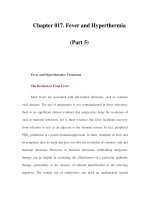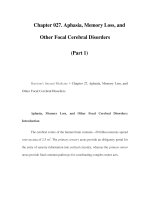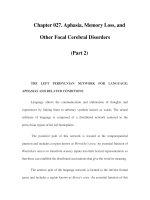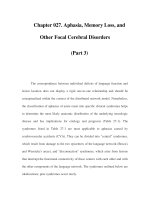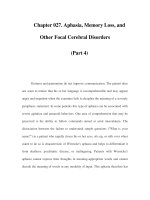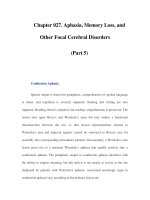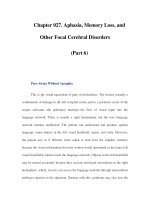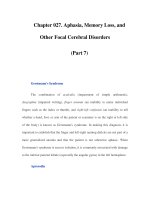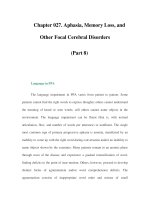Chapter 031. Pharyngitis, Sinusitis, Otitis, and Other Upper Respiratory Tract Infections (Part 5) pdf
Bạn đang xem bản rút gọn của tài liệu. Xem và tải ngay bản đầy đủ của tài liệu tại đây (14 KB, 5 trang )
Chapter 031. Pharyngitis, Sinusitis, Otitis, and Other
Upper Respiratory Tract Infections
(Part 5)
Infections of the Ear and Mastoid
Infections of the ear and associated structures can involve both the middle
and external ear, including the skin, cartilage, periosteum, ear canal, and tympanic
and mastoid cavities. Both viruses and bacteria are known causes of these
infections, some of which result in significant morbidity if not treated
appropriately.
Infections of the External Ear Structures
Infections involving the structures of the external ear are often difficult to
differentiate from noninfectious inflammatory conditions with similar clinical
manifestations. Clinicians should consider inflammatory disorders as a possible
cause of external ear irritation, particularly in the absence of local or regional
adenopathy. Aside from the more salient causes of inflammation such as trauma,
insect bite, and overexposure to sunlight or extreme cold, the differential diagnosis
should include less common conditions such as autoimmune disorders (e.g., lupus
or relapsing polychondritis) and vasculitides (e.g., Wegener's granulomatosis).
Auricular Cellulitis
Auricular cellulitis is an infection of the skin overlying the external ear and
typically follows minor local trauma. It presents with the typical signs and
symptoms of a skin/soft tissue infection, with tenderness, erythema, swelling, and
warmth of the external ear (particularly the lobule) but without apparent
involvement of the ear canal or inner structures. Treatment consists of warm
compresses and oral antibiotics such as dicloxacillin that are active against typical
skin and soft tissue pathogens (specifically, S. aureus and streptococci). IV
antibiotics, such as a first-generation cephalosporin (e.g., cefazolin) or a
penicillinase-resistant penicillin (e.g., nafcillin), are occasionally needed for more
severe cases.
Perichondritis
Perichondritis, an infection of the perichondrium of the auricular cartilage,
typically follows local trauma (e.g., ear piercing, burns, or lacerations).
Occasionally, when the infection spreads down to the cartilage of the pinna itself,
patients may also have chondritis. The infection may closely resemble auricular
cellulitis, with erythema, swelling, and extreme tenderness of the pinna, although
the lobule is less often involved in perichondritis. The most common pathogens
are P. aeruginosa and S. aureus, although other gram-negative and gram-positive
organisms are occasionally involved. Treatment consists of systemic antibiotics
active against both P. aeruginosa and S. aureus. An antipseudomonal penicillin
(e.g., piperacillin) or a combination of a penicillinase-resistant penicillin plus an
antipseudomonal quinolone (e.g., nafcillin plus ciprofloxacin) is typically used.
Incision and drainage may be helpful for culture and for resolution of infection,
which often takes weeks. When perichondritis fails to respond to adequate
antimicrobial therapy, clinicians should consider a noninfectious inflammatory
etiology; for example, relapsing polychondritis is often mistaken for infectious
perichondritis.
Otitis Externa
The term otitis externa refers to a collection of diseases involving primarily
the auditory meatus. Otitis externa usually results from a combination of heat,
retained moisture, and desquamation and maceration of the epithelium of the outer
ear canal. The disease exists in several forms: localized, diffuse, chronic, and
invasive. All forms are predominantly bacterial in origin, with P. aeruginosa and
S. aureus the most common pathogens.
Acute localized otitis externa (furunculosis) can develop in the outer third
of the ear canal, where skin overlies cartilage and hair follicles are numerous. As
in furunculosis elsewhere on the body, S. aureus is the usual pathogen, and
treatment typically consists of an oral antistaphylococcal penicillin (e.g.,
dicloxacillin), with incision and drainage in cases of abscess formation.
Acute diffuse otitis externa is also known as swimmer's ear, although it can
develop in patients who have not recently been swimming. Heat, humidity, and the
loss of protective cerumen lead to excessive moisture and elevation of the pH in
the ear canal, which in turn lead to skin maceration and irritation. Infection may
then occur; the predominant pathogen is P. aeruginosa, although other gram-
negative and gram-positive organisms have been recovered from patients with this
condition. The illness often starts with itching and progresses to severe pain,
which is usually triggered by manipulation of the pinna or tragus. The onset of
pain is generally accompanied by the development of an erythematous, swollen
ear canal, often with scant white, clumpy discharge. Treatment consists of
cleansing the canal to remove debris and to enhance the activity of topical
therapeutic agents—usually hypertonic saline or mixtures of alcohol and acetic
acid. Inflammation can also be decreased by adding glucocorticoids to the
treatment regimen or by using Burow's solution (aluminum acetate in water).
Antibiotics are most effective when given topically. Otic mixtures provide
adequate pathogen coverage; these preparations usually combine neomycin with
polymyxin, with or without glucocorticoids.
